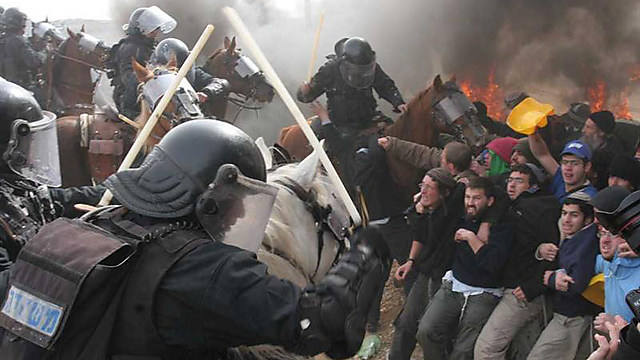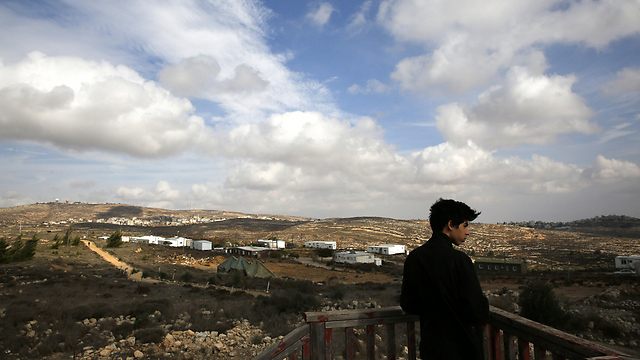Op-ed: Israel must pass a law to prevent the recurrence of cases like Amona by settling once and for all land-ownership issues and setting a clear land registration system that overrides all others.
The winter of 2006 is seared into the collective memory of many Israelis. Thousands of police officers—many mounted on imposing horses—converged on helpless families, attempting to protect their homes from a forced evacuation and demolition. The site was the outpost of Amona, just a short 1.5 kilometer drive up a hillside overlooking the well-established (in 1975) community of Ofra. The haunting images of young girls lying on the road as horses trampled them will not soon be forgotten.
But ten years later, in the fall of 2016, the residents of Amona are once again facing the possibility of a forced eviction. The forty mobile homes that survived the first evacuation are the current bone of contention.
How did we get here?
Since the State of Israel returned to the historical lands of Judea and Samaria in 1967, the settlement process in the area has lacked a clear governmental policy, often shifting with different competing political imperatives. This is never more evident than when it comes to neighborhoods known as outposts communities, such as Amona, which are often called “illegal outposts,” although it would be more accurate to refer to them as “unauthorized outposts”. The reason is that outposts such as Amona were incorporated in an overall site plan that envisioned a future residential neighborhood, however due to political pressures, the necessary zoning or land use changes were never issued.

Over the years, the residents of Amona have generally enjoyed the support of their government regardless of whether it was a right or left leaning government.
This was the case, for example, in regard to the “outpost agreement,” which set many outposts, including Amona, on the path toward legal compliance under Ehud Barak’s government in 2001, and the active encouragement provided to the communities in Judea and Samaria by Ariel Sharon’s government. And certainly at the founding of Amona, it was the Israeli government that granted its legal seal of approval and enabled water and sewage to be hooked up to Israeli systems, provided mass transit and school buses to Amona, etc. The government in action and deed clearly supported the development of Amona.
This experience of the government’s wavering support for outposts has been repeated in many other communities. Some towns were initially established as outposts and over the years and with the government’s help grew into well-established authorized/legalized communities. That is how Yitzhak Rabin came to establish Ofra. Shimon Peres was credited with the establishment of Sebastia in the northern Samaria. Infrastructure was built at these sites, roads replaced the clay and dirt roads, and generators gave way to the public electricity infrastructure. Now, however in the case of Amona, the residents are discovering that the same government that gave the settlers the land with its right hand has the ability to evacuate them from that very same land with its left hand.
Not many people are aware that the legal registration of land rights in Judea and Samaria is currently based on the Ottoman legal land registry system, which is 500 years old. Israel still respects the laws of the Hashemite Kingdom of Jordan, which controlled Judea and Samaria for a mere 19 years (1948-1967) and has not been in control of them for the past 50 years. In the middle, in those lacunae between the Ottoman and Jordanian legal systems, enter the laws of the State of Israel.

But as noted, the absence of a clear governmental policy vis-à-vis construction in Judea and Samaria may lead to families being evacuated from their homes after having lived in them for thirty years or more. Banks provided mortgages, the state built the infrastructure, and the schools are running smoothly. However, a petition to the High Court of Justice by some anti-Israel organization can bring about the destruction of a settlement should the court decide that there is an issue with the title or that a home was built on privately-owned land and must be demolished – a home that the state had determined was to be built on state-owned land and had approved it for construction years earlier.
The gap exists, among other reasons, due to the technical fact that over the years, no fewer than three different land-use maps were drawn at different times, using different technologies and based on the different data available at the time. Twenty-five years ago, it was thought that Amona’s land was state land. More recently, it became clear just a few years ago that it is privately-owned land. The different information became available thanks to modern technology whereby the map was literally able to be read more accurately. As a result, land previously considered state land can suddenly become private land and vice versa.
This is state-sponsored chaos.
If Israel is looking for a comprehensive solution to prevent the recurrence of cases like Amona, it must pass a law that can solve the problems created by technological gaps from the past, a law that will settle once and for all the status of the land rights and which a clear land registration system overrides all others.
As reported by Ynentews
